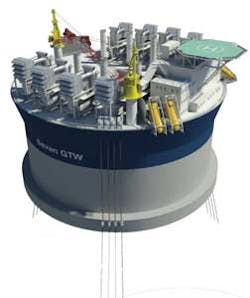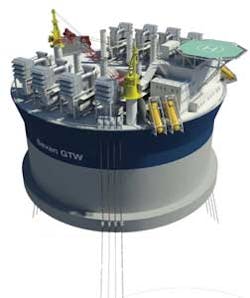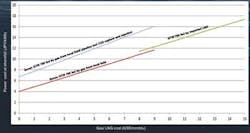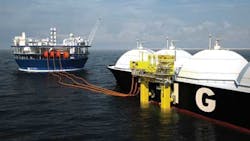Nick Terdre
Contributing Editor
Sevan Marine is developing new applications for its cylindrical floater technology. To date, the Arendal, Norway-based contractor has designed and supplied floaters for use as FPSOs, drilling rigs and accommodation units: It delivered its first flotel to Teekay in February. More recently, its focus has been on concepts for floating storage and offloading units (FSO); gas-handling operations such as FLNG and floating storage and regasification (FSRU); and studies for power plants and carbon capture.
The company has now developed an offshore regasification/power generation concept intended that could meet Japan's energy needs in the post-Fukushima age, as the country seeks to switch out of nuclear power and replace it largely with imported gas and renewable energy.
Sevan delivered a presentation to Japanese utility companies in December, according to Chief Business Development Officer Fredrik Major. The proposal also met with interest in government circles – a representative of the Japanese energy ministry accompanied Major and his colleagues while they were in the country, and ministry representatives expressed their intention of promoting funding for a study of the concept.
While Japan has long been a large-scale importer of LNG, one particular advantage of floating regasification is that the operation can take place far from shore and is therefore safe from the risk of earthquakes and tsunamis, as well as being remote from inhabited areas. By adding a power plant, the need for an onshore gas terminal and electricity plant is also eliminated.
The floater that Sevan envisages for these operations is a mid-size unit, the same as its FLNG unit. Regasification requires less equipment than liquefaction, thereby freeing up space for the power plant. Sevan's process subsidiary KANFA Aragon would engineer the regasification facilities, while the company's partnership with Siemens would take care of the power generation. This would use Siemens' widely-sold SGT-800 combined-cycle industrial gas turbine.
The application would require two 350 MW blocks, each comprising five SGT-800 gas turbine generator sets, five heat recovery steam generators and one SST-900 steam turbine generator set. Generation efficiency is close to 55%. Siemens would also be responsible for design of the power transmission facilities. Power could be transferred ashore as either high-voltage AC or DC current. Sevan foresees a four-year period from front-end engineering and design (FEED) through construction and outfitting to delivery of a fully commissioned unit.
DNV GL has also been involved in the concept development, providing safety and risk evaluations and third-party verification as well as overseeing regulatory compliance.
To generate 700 MW, the required gas is around 120 cf/d (3.4 cu m/d), equivalent to 5,800 cu m/d (204,825 cf/d) of LNG. The LNG storage capacity is about 200,000 cu m (7.063 MM cu ft), sufficient for some 35 days' generation.
Another potential application, also relevant to Japan, would be to use the floating power plant in combination with an offshore wind farm, acting as a swing producer to keep the amount of power supplied to shore constant in the face of fluctuating output from the wind farm. In this case the floater and the wind farm would share common transmission facilities. While LNG would be the obvious gas source in the case of Japan, elsewhere the floating power plant could be powered by gas from local sources. One example is Myanmar, which has its own gas reserves but a deficit in local energy generation.
Adjustable power
Without the need for regasification equipment, it would be possible to install a carbon capture system on the floater to work in conjunction with the power plant. The feasibility of this concept, known as Sevan's GTW 700 post-combustion carbon-dioxide (CO2) capture plant, has been established in two studies by the SINTEF research institute in Trondheim, Norway. These showed that the facilities can be easily integrated with a natural gas-fired power plant on a Sevan floating structure. The process enables up to 90% CO2 capture, although it reduces the net efficiency of power generation to around 45%, or 570 MW. The captured CO2 is compressed to liquid form for injection into a subsurface storage reservoir.
Other benefits of the floating power plant are that the power rating can be adjusted in 70 MW steps, and thus closely tailored to the need at any time. As with any floater, the unit is mobile and can be easily relocated. Sevan envisages that a utility or group of utilities under a company license would own the unit – as is the case of the Goliat FPSO in the Norwegian Barents Sea, owned by Eni, and Dana's Western Isles FPSO east of Shetland in UK waters.
Sevan's technology, being geostationary, does not require turret mooring, unlike conventional ship-shape floaters. The turret system that allows a ship-shape FLNG unit to weathervane is a major cost element. In the case of Shell's Prelude offshore northern Australia, for example, the price tag for the 100-m (328-ft) high, 12,000-metric ton (13,228-ton) turret is thought to be $500 million or more. Moreover, importing gas through a swivel is a technically demanding and potentially hazardous operation, but this is not required in the case of the circular floater.
Sevan's operating experiences with its circular FPSOs have confirmed other inherent engineering advantages compared with ship-shape or conventional semisubmersible hulls. These, the company claims, include insignificant bending stresses; elimination of wave-induced fatigue loads; minimal hull deflections; lower pitch and roll motions; and lower heave acceleration and amplitude.
Topsides/storage arrangement
The hull of the company's FLNG design has a 106-m (348-ft) diameter and a double bottom, supporting a three-deck topsides: uppermost is the process deck, with an area of 13,000 sq m (139,931 sq ft), with a utility deck underneath, and below that the main deck. Total topsides weight is 31,500 metric tons (34,723 tons), of which 17,000 metric tons (18,739 tons) is accounted for by the gas processing and liquefaction facilities. There is storage capacity for 180-210 cu m (6,357-7,416 cu ft) of LNG in six main tanks, 20,000 cu m (706,293 cu ft) of liquid petroleum gas (LPG) in a central tank (which could also be used for LNG if LPG storage is not required); and 250,000 bbl of condensate in six smaller tanks – condensate and LPG are extracted during the pre-processing process.
The liquefaction process makes use of KANFA Aragon's patented technology which is based on the well-proven dual nitrogen expander cycle optimized for offshore application and reportedly using up to 15% less energy than similar dual expander cycles. The FLNG unit is equipped with two LNG trains, each sized to produce 1.2 MMt/yr of LNG, making a total capacity of 2.4 MMt/yr based on a gas feed of 333 MMcf/d.
The process requires a large intake of cooling water – typically 18,000 cu m/hr (635,664 cu ft/hr) for 2.4 MMt/yr. In areas with high sea water temperatures, process efficiency can be significantly improved, Sevan adds, by taking colder water from deep down through free-hanging vertical hoses. Again, as the unit is stationary, there is no interference between the hoses and the mooring or risers to prevent the deep deployment of these hoses.
There is flexibility with respect to hull fabrication, which can be performed in a drydock, on a skidway, slipway or submersible barge. The self-supporting prismatic type B SPB tanks included in the design are prefabricated, offering a choice of location, while the membrane tanks are fabricated in situ. The topsides are modularized and fabrication can therefore take place at a variety of locations.
Hull/topsides integration and topsides hook-up will normally take place in the hull fabrication yard, allowing a fully commissioned unit to be delivered and on-field hook-up reduced to a minimum. Transportation to the field location can either involve a dry tow on the back of a heavy-lift vessel, in the case of a longer distance, or a wet tow, with a full crew on board if desired.
Major claims the cost of the Sevan FLNG unit would be reasonably competitive, at just under $1 billion/MMt per year. And there are further advantages in terms of offloading of LNG to tankers. For the standard ship-shape unit, the normal method is to have the tanker moored alongside, meaning that the two vessels are in contact. In such circumstances loading operations are limited to relatively low sea states. Use of hinged loading arms for LNG transfer also means there are restrictions on the relative motions that can be permitted.
Various methods, in contrast, are feasible with the Sevan FLNG unit, including side-by-side offloading to a conventional LNG carrier alongside the platform, or offset side-by-side, with the carrier stationed a small distance from the platform.
These would allow loading operations in sea states up to 2.5 and 3.5 m (8.2 and 11.5 ft) significant wave heights respectively. Operations in up to 4.5 m (14.7 ft) sea states would be possible through tandem offloading to carriers adapted for bow loading.
Last year, in recognition of the need for loading in higher sea states, Sevan acquired the LNG loading technology that employs the HiLoad docking system, establishing the company's HiLoad LNG for this purpose. The HiLoad unit, which is equipped with four thrusters and a DP-2 dynamic positioning system, carries the loading hose to the tanker, locking onto its side and holding it in position while loading takes place. The fixed connection means there are no relative motions between the HiLoad unit and the tanker, allowing operations to take place in sea states in excess of 4.5 m. It also means that standard LNG carriers can be used, without any modifications.
LNG is transferred through a cryogenic floating hose. Trelleborg has developed a 20-in., 20-bar (290-psi) hose for this purpose, which is currently undergoing qualification to the EN1474-II standard.
Operating costs for Sevan floaters of all types are comparatively low, the company adds, mainly because there is no turret requiring regular maintenance. Experience from the North Sea floaters indicates a need for an overall crew of about 30, a savings of roughly five compared with a conventional FPSO of equivalent capacity. The marine crew only works the day shift.






